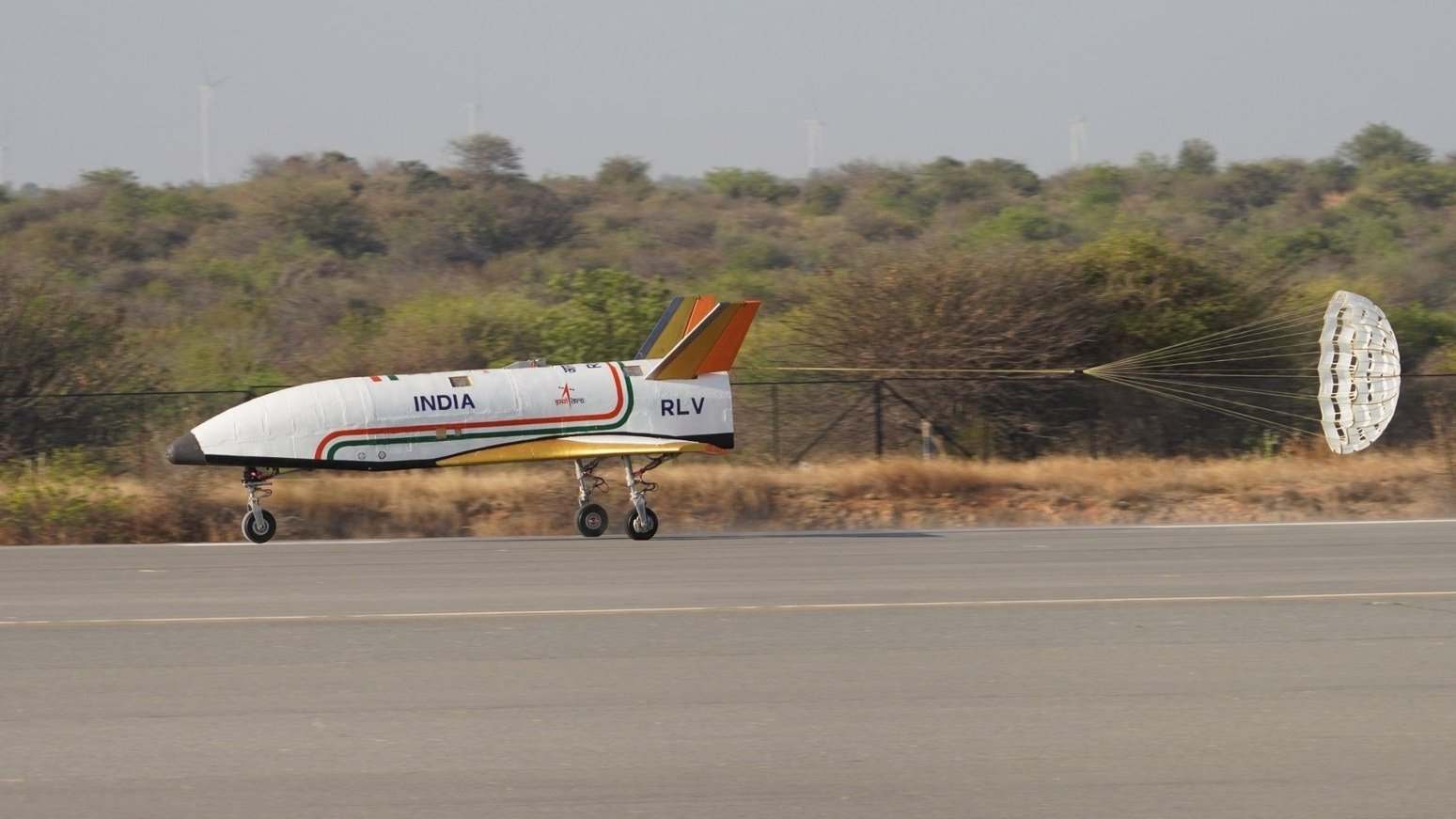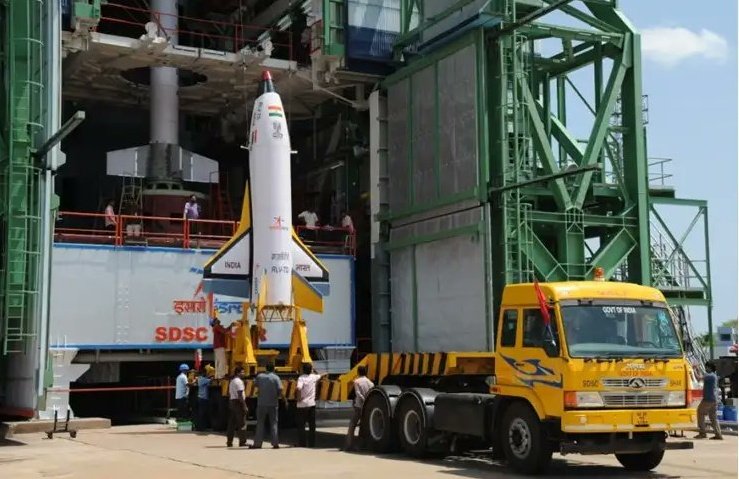OPED by Prof (Dr) Dinesh Kumar Pandey
ISRO accomplished the autonomous landing of a Reusable Launch Vehicle Autonomous Landing Mission (RLV LEX) on April 2 during a test at the Aeronautical Test Range (ATR) in Chitradurga, located in Karnataka, in the presence of the Indian Space Research Organization (ISRO) Chairman S. Somanath.
At 7.10 am India time, an Indian Air Force’s (IAF’s) Boeing-made Chinook helicopter took off with the RLV stowed beneath its belly. It climbed to 4.5 kilometers in the air (above Mean Sea Level).
The vehicle landed in Hypersonic Flight Experiment (HEX) on a makeshift runway high over the Bay of Bengal. The HEX mission did not require any practice landings on real runways to complete.
Why RLV?
Despite a history spanning over 40 years and a total of 135 launches, the United States was ultimately compelled to give up using the NASA Space Shuttles. These shuttles turned out to be exorbitantly expensive and quite risky to operate.
Fourteen astronauts involved in the space shuttles Challenger (1986) and Columbia (2003) were killed in separate accidents. Consequently, the program was terminated in 2011, and all shuttles were scrapped.
The failure of the space shuttle compelled space research organizations worldwide to concentrate on developing unmanned launch systems and vehicles that are both less expensive and safer to use.
The expense involved in sending satellites or humans into space is significant. Therefore, since the first step humans took on the moon, space community members — including engineers, policymakers, and others — have had the consistent goal of developing and designing a vehicle capable of carrying out multiple-launch missions. The vehicle is similar to an aircraft that can be used for either cargo transport or military purposes.
The Reusable Launch Vehicle (RLV) is the space analog of an aircraft. It takes off vertically on the back of an expendable rocket and then glides back down to Earth like an aircraft. During the landing phase, an RLV can either land on a runway or perform a splashdown. Several tests will be performed on the RLV, including the following:
Hypersonic Flight Experiment (HEX): The launch will be the foundation for the first experiment. RLV will be discarded into space after being propelled there by a solid booster rocket.
The lofted RLV will independently re-enter the atmosphere and be guided to a controlled splashdown, while the booster rocket will fall into the water and explode. This evaluation was observed keenly.
Landing Experiment (LEX): The turbofan engine housed within the RLV will be tested in the second experiment. First, the RLV-TD will be propelled into space in a manner analogous to that of the HEX. After that, it will re-enter the atmosphere at a hypersonic speed and then slow down by applying aerodynamic braking.
After that, it will perform a two-g turn in the direction of its launch site, and once it reaches 0.8 Mach, its turbofan engine will begin operating. Then, it will make a horizontal landing on a runway after cruising to the launch site at a speed of 0.6 Mach.
Experiment on Return Flight (REX): As part of the third experiment, the RLV-TD will be launched into orbit, and after it completes its mission in space, it will be brought back to Earth, where it will be landed on a runway.
Scramjet Propulsion Experiment (SPEX): The final experiment will determine how well an RLV-TD, modified with an air-breathing scram jet engine, performs.
Mission Specifications
On confirmation from the onboard Mission Management Computer that the predetermined conditions of the pillbox had been met, the system gave the order to send the RLV into the air at a downrange of 4.6 kilometers.
Because of its low lift-to-drag ratio, RLV was required to approach the landing at high glide angles to land at high speeds of 350 kilometers per hour. The criteria for releasing the RLV included ten different characteristics, including coordinates, speed, altitude, and heart rate.
After executing approach and landing maneuvers with the assistance of the Integrated Navigation, Guidance, and Control System at approximately 7.40 am, the RLV successfully performed an autonomous landing on the ATR airstrip.
To prevent any mishap, it was necessary to have precise navigation hardware and software, a pseudolite (pseudo-satellite) system (for Positioning Information), a Ka-band radar altimeter, indigenous landing gear, aerofoil honeycomb fins, and a braking parachute system.
ISRO has developed localized navigation systems using satellite positioning technology, such as pseudolites, instruments, and sensors. The Ka-band radar altimeter generated the Digital Elevation Model (DEM) of the landing site, making it possible to determine the landing site’s elevation with a high degree of accuracy.
Extensive testing in wind tunnels and computational fluid dynamics simulations were carried out before the RLV’s first flight to make it possible to characterize its aerodynamic performance.
Applying the cutting-edge technology developed for the RLV LEX to other operational launch vehicles of ISRO makes it possible to reduce overall launch costs.
ISRO demonstrated the re-entry of its wing vehicle, the RLV-TD, during the HEX mission in May 2016. The demonstration was a success. The progression of RLVs was pushed forward substantially with the successful re-entry of a hypersonic sub-orbital vehicle.
The final approach phase of the LEX mission was successfully accomplished, and the re-entry return flight route demonstrated an autonomous high-speed landing (350 kilometers per hour).
In 2019, the LEX began with an Integrated Navigation Test, and in the years that followed, it was followed by a flurry of Engineering Model Trials and Captive Phase Trials.

ISRO, IAF, Center for Military Airworthiness and Certification (CEMILAC), Aeronautical Development Establishment (ADE), and Aerial Delivery Research and Development Establishment (ADRDE) worked together on this test as part of a collaborative effort. Dr. Jayakumar M. is the director of the RLV project, and Muthupandian J. is in charge of leading the expedition.
The IAF crew collaborated closely with the project team and flew multiple missions to perfect the circumstances for release and meet all requirements. Initially, the mission was planned with a Russian Mi-17 helicopter. Later Mi-17s were replaced by the American Chinook.
Objectives Of ISRO’s RLV
ISRO’s RLV is an attempt to create core technologies for a fully reusable launch vehicle, which would make space travel more affordable. The new system will further solidify the Indian space agency’s position as the most cost-effective launch service provider in the multibillion-dollar satellite launch market.
The primary purpose behind developing the reusable system is to strengthen ISRO’s position in the launch market, which SpaceX currently dominates due to the company’s reusable Falcon-9 rockets.
On the back of its reusable system, the company led by Elon Musk completed 61 successful launches in 2022 and has plans to increase that number to 100 in 2023. ISRO intends to compete in this market, and a launch vehicle that can be reused will help it to do so.
The President of SpaceX, Gwyneth Shotwell, stated that the company could anticipate up to 30% cost savings by reusing the first stage. If this translated into a 30% reduction for customers, that would significantly bring down Falcon 9’s advertised price from its current US$61.2 million to US$42.8 million.
The system’s primary goal is to develop a hypersonic aero thermodynamic characterization of the wing body. Other objectives of the system include:
- The evaluation of autonomous navigation, guidance, and control schemes,
- Integrated flight management, and
- Assessment of a thermal protection system.
The ISRO successfully tested the RLV-RD from Sriharikota. This flight test validated several essential technologies, including an autonomous navigation, guidance, and control system; a reusable thermal protection system; and re-entry mission management.
ISRO claims that the RLV’s configuration is identical to that of an airplane and that it, thus, combines the complexity of an aircraft and launch vehicles. ISRO has designed the winged RLV-TD to function as a flying test platform to analyze technological advancements, including hypersonic flight, autonomous landing, and powered cruise flight.
The system includes the fuselage (body), nose cap, two sets of delta wings, two sets of vertical tails, and active control surfaces (Elevons and Rudder). The system reaches Mach 5 with the help of a standard, low-burn-rate solid booster.
Mission’s Significance
The RLV LEX mission was significant since it was the first time that an Indian spacecraft was able to land successfully without the assistance of humans. This autonomous landing replicated all of the characteristics of a Space Re-entry Vehicle, including a high landing speed, the absence of a landing crew, and landing precision from the same trajectory as the return trip.
In addition, landing characteristics — such as the ground’s relative velocity, the landing gears’ sink rate, and actual body rates — were achieved, imitating the conditions that a spacecraft returning from orbital re-entry may experience.
Challenges Of Reusable Launch Vehicles
The development of RLV is still in the nascent stage. Therefore, it needs adequate R&D. Several countries are working on it to make it a rugged platform.
The most significant development gaps of reusable launch vehicles are as follows:
Reusability necessitates adding additional systems, landing gear, or fuel to return and land. Because of this, the rocket’s mass and dimensions will increase, resulting in improved launch preparation requirements.
The reusable stage requires maintenance and repairs every time it’s used. As a result, it may not be suitable for reuse because the costs associated with restoring it will be higher than those related to creating a new phase.
Because this danger is ever-present, every component that can be reused is given a time limit, after which it can no longer serve its intended purpose.
Despite this, it is indisputable that a launch vehicle that can be reused offers numerous advantages, and it is likely that in the not-too-distant future, all future launch missions will transition entirely to using such vehicles for space travel.
Conclusion
With the completion of the LEX project, India has moved one step closer to realizing its dream of having a reusable launch vehicle.
Furthermore, ISRO’s aspirations to develop space capacity building have been bolstered by the fact that the Mars Orbiter Mission completed its primary objective on the first try.
As a result, it would be possible to showcase India’s technological prowess and the country’s progress in space exploration by using a highly developed version of the RLV to launch satellites and astronauts.
India will be able to expand its space technology and capabilities with the help of the experiments that need to be carried out. These experiments will culminate in a fully developed version of RLV.
The success of the RLV program will reduce the cost of space missions, increasing India’s competitiveness in the launcher market. For now, the test program will broaden India’s technological capabilities, allowing the country to pioneer space exploration soon.
- Prof (Dr) DK Pandey, [Gp Capt (Retd)], is a Senior Fellow at the Center for Air Power Studies
- Follow EurAsian Times on Google News





